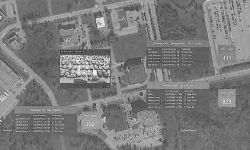Michigan State shooting: Alerts to students delayed as police rushed to campus

March 8: Michigan State shooting: University lacked security common on other campuses
March 1: MSU police can’t explain 13-minute alert gap, remain mum on shooting details
EAST LANSING — Michigan State University police acknowledge their initial attempt to warn students of a campus gunman was delayed because every officer on duty had rushed to confront the shooter.
Deputy Police Chief Chris Rozman told Bridge Michigan on Monday that all officers “heroically went toward the threat” after the first 8:18 p.m. report on Feb. 13 of shots fired at Berkey Hall, where the gunman had killed two students.
But that “overwhelming” physical response left no one at headquarters capable of logging into a computer system required to send an emergency alert to students, Rozman said, so responding officers called an off-duty colleague who was able to issue an initial alert from his home computer.
Related:
- As Michigan boosts school security after shootings, how much is too much?
- Michigan State shooting victims: Two more students released from hospital
- MSU shooting: fourth victim identified, discharged from hospital
- MSU shooting update: University to ask state for more security money
- Michigan State students demand tougher security at emotional town hall
The “Run. Hide. Fight” message was sent to students at 8:31 p.m.
By then, the gunman — later identified as Anthony McRae, 43, from Lansing — was already entering the MSU Union, where he killed a third student, Brian Fraser, 20, of Grosse Pointe Park.
It’s unclear exactly how long the staffing situation delayed the initial notification, but MSU police have previously warned students of suspected campus gunmen in as little as four minutes.
The first public accounting of the MSU alert process follows a series of complaints from students who have questioned why they weren’t notified sooner the night of the shooting — and in some cases received an email rather than a text warning them of danger..
“We had a total of 15 minutes not knowing what was going on, as well as not knowing where to avoid,” student Maren Freifeld said at a campus town-hall meeting last week.
“I don’t know who was (sending out) those emails, but that was a hard flop.”
Overall, public officials including Gov. Gretchen Whitmer have praised the overwhelming police response from numerous agencies who flooded the MSU campus to help protect students and try to find the shooter.
The gunman killed himself off-campus hours after the shooting when he was confronted by police. The man also shot five other students, who were critically wounded.
“(Police) did … what they’ve been trained to do, and what they’ve been preparing to do,” Rema Vassar, president of the Michigan State Board of Trustees told Bridge Michigan last week.
“Could anything be improved? That's yet to be seen.”
Prior to the Feb. 13 shooting, the university was working to improve campus security by creating a centralized security operation center that will eventually be staffed 24-hours a day by a full-time employee who, among other things, will be tasked with issuing emergency notifications, according to Rozman.
"It's just unfortunate it wasn't ready the other week," said Andrew Miller-Thomas, a 21-year-old student who was in the MSU Union when McRae opened fire.
Miller-Thomas told Bridge that the first MSU police alert was irrelevant to him by the time it hit his phone on Feb. 13. He had already been warned by a fellow student after leaving his meeting of the University Activities Board.
"I basically almost walked into the hallway where (the shooter) was before a guy stopped me and told me what was going on," Miller-Thomas said, explaining how he returned to the Union meeting room to help colleagues barricade the door.
A Bridge review shows students must opt-in to text message alerts at MSU, where the system instead defaults to emails. The university did not ask state police or the Ingham County Sheriff for use of a state system that could have sent more prominent phone alerts to anyone near the East Lansing campus, according to public records and interviews.
“I think Michigan State did 95 percent of things right,” said Miller-Thomas, who credited police with a large response to the shooting but also questioned why the MSU Union does not have a public announcement system to warn students.
“It was just the lack of preparation in terms of easy things they could have done.”
To be sure, within seconds of Michigan State’s first message at 8:31 p.m., personal and social media networks exploded, instantly amplifying the message across campus to friends and family.
18 alerts since September
University police have issued similar alerts considerably faster in the past: It took MSU four minutes to warn of a gunman in 2014, sparking a reported Union lockdown for what turned out to be a false alarm.
That reported gunman was actually a Reserve Officers' Training Corps (ROTC) member carrying a ceremonial, replica gun. Six minutes after telling students to secure-in-place, police sent students a second alert lifting that order and explaining there was no real threat.
MSU hasn't changed its alert protocols much in the past nine years, but the university was likely able to issue a notification faster in that case because the threat was reported mid-day, Rozman said.
During "business hours" there "are more personnel that we have sitting in front of a computer that have the ability to launch an alert," he told Bridge.
Universities are required to maintain an emergency notification system for students under a federal law that also requires them to report crime and fire data each year.
But the statute does not require text notifications, and MSU has for years defaulted to sending alerts to student email accounts.
Dan Olsen, an MSU spokesperson, told Bridge that MSU encourages all students to opt-in to text message alerts during freshman orientation. They can also opt in later, and anyone – including friends, family or community members – can sign up for alerts by texting MSUALERT to 888777.
The university ended up sending out multiple emergency alerts – along with Twitter messages – during what turned out to be a prolonged manhunt for the gunman as well as false reports of gunshots and suspicious people.
“The vast majority of students obviously sheltered in place, but we were getting some reports that some students may not have,” Olsen said. “So we made the decision to issue the alert again.”
East Lansing also used its voluntary text-message system on Feb. 13, sending a public safety alert at 8:40 p.m., nine minutes after Michigan State did.
Since Sept. 1, Michigan State has sent 18 alerts via text message or email, ranging from reports of stolen mopeds, a road closure for high water, an armed robbery, a “gunshots fired” and assaults. Two welcomed students to campus.
Miller-Thomas said he and fellow students made fun of the alerts in freshman dorms and said there “is a little bit of fatigue” on campus from students who feel they receive too many texts. Others who didn’t sign up for texts told Bridge it is easy to overlook email alerts in a crowded inbox.
‘Public threat alert’ system not activated
Under a 2016 Michigan law, the university could have also requested use of a state-run system to send “public threat alerts” to anyone whose cell phone was connected to a local tower.
Additionally, Ingham County could have used the state system to send out alerts on MSU's behalf because it is the region's designated emergency management agency, according to Michigan State Police.
While MSU didn’t have direct access during the shooting, the university is now “looking at and having conversations with our local 9-1-1 dispatch center which does have access to that system to see what we might be able to do going forward,” said Olsen, the spokesperson.
"Using that system is not in our current policies, although we always look to evaluate ways to strengthen our response and leverage different systems," added Rozman, MSU’s deputy police chief.
"So... that could be one thing that we look at in the future."
The state-run system is designed to send out public threat alerts in a similar fashion to AMBER Alerts. The notifications look like text messages but are more prominent because they effectively take over a person's phone with alarms and vibration. And unlike MSU texts, there is no opt-in required.
Michigan lawmakers allowed local police agencies to request use of the system seven years ago after a mass shooting in Kalamazoo County, where Uber driver Jason Dalton had killed six people and injured two others.
But local requests have been rare. As of 2021, five years after her predecessor signed the law, Gov. Gretchen Whitmer said the “public threat alert” option had been used just once — to warn of an active shooter.
Former state Rep. David Maturen, one of the legislative sponsors of the 2016 law, said he is not sure why it has not been used more often in situations like the MSU shooting.
"It was meant to be a coordinated alert so that anybody within a community would know” and “take caution,” Maturen told Bridge.
The law tasks Michigan State Police with running the public threat alert system, which can be used to warn of a "specific and identifiable threat" such as an active shooter, mass shooting or bombing.
County-level emergency management agencies can also use the broader state alert system without MSP approval. Records show that’s happened nearly 150 times in Michigan since October 2020. Many of the alerts were tests or weather-related, but some were not.
Just over a month before the shooting at Michigan State, Calhoun County sent out an alert to people in southeast Marshall alerting them to an “armed and dangerous” man on Jan. 11.
The alert went out at 8:29 p.m.; an “all clear” went out at 9:52 p.m. “The wanted/dangerous subject has been located by law enforcement. This individual no longer poses a danger to the community.”
— Yue Stella Yu and Ron French contributed to this story
Michigan Education Watch
Michigan Education Watch is made possible by generous financial support from:
Subscribe to Michigan Education Watch
See what new members are saying about why they donated to Bridge Michigan:
- “In order for this information to be accurate and unbiased it must be underwritten by its readers, not by special interests.” - Larry S.
- “Not many other media sources report on the topics Bridge does.” - Susan B.
- “Your journalism is outstanding and rare these days.” - Mark S.
If you want to ensure the future of nonpartisan, nonprofit Michigan journalism, please become a member today. You, too, will be asked why you donated and maybe we'll feature your quote next time!





